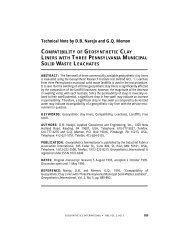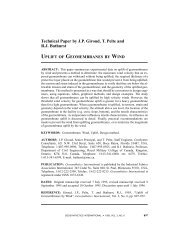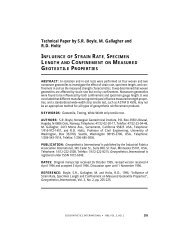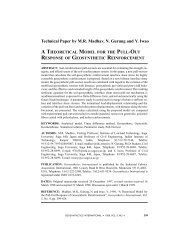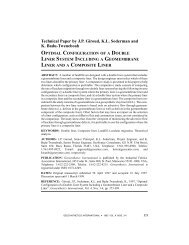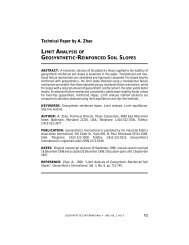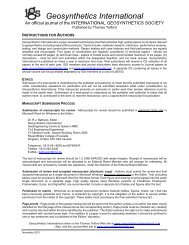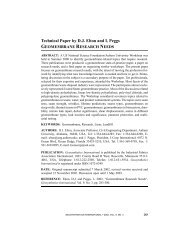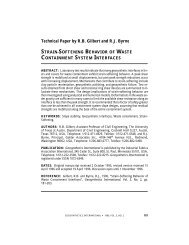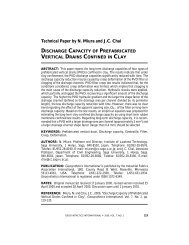Technical Paper by B.C. Rawes - IGS - International Geosynthetics ...
Technical Paper by B.C. Rawes - IGS - International Geosynthetics ...
Technical Paper by B.C. Rawes - IGS - International Geosynthetics ...
Create successful ePaper yourself
Turn your PDF publications into a flip-book with our unique Google optimized e-Paper software.
RAWES D Parameters for Prefabricated Vertical Drain Specification<br />
Reservoir<br />
Water outlet<br />
Pressure cell<br />
Water overflow<br />
Δh<br />
Flow gauge<br />
L<br />
Drain specimen<br />
(PVD)<br />
Latex membrane<br />
Water inlet<br />
Figure 2.<br />
Schematic layout of Delft PVD discharge test apparatus.<br />
q w = Q i<br />
(3)<br />
where: Q = water flow through the PVD; i = hydraulic gradient = Δh/L;andΔh = head<br />
loss over PVD length, L.<br />
In Figure 3, the results from a Delft test apparatus are presented and compared with<br />
results from an ASTM D 4716 test, and the NTU (Nanyang Technological University)<br />
drain tester on the same PVD material. The value of q w at a 350 kN/m 2 confining pressure<br />
varies between 35×10 -6 and 79×10 -6 m 3 /s. The NTU and the ASTM D 4716 test<br />
methods are described below.<br />
At the Nanyang Technological University of Singapore, a simple discharge capacity<br />
tester for PVDs (Broms 1994) was developed to provide a simple quality control test<br />
method for PVD projects in Singapore. In this test, the PVD is compressed, using site<br />
specific clay/silt material in contact with the PVD, in 100 kPa steps from 50 to 350 kPa.<br />
Each load step is held for one hour. The hydraulic gradient used as a reference for the<br />
results of the NTU test is i = 0.5, and the test is conducted to ensure laminar flow. Akagi<br />
(1994) noted the need to ensure laminar flow conditions and recommended a hydraulic<br />
gradient range for testing of i = 0.2 to 0.5.<br />
Let us now consider the ASTM D 4716 discharge test which has been the most commonly<br />
specified standard discharge test in recent years. First, it should be understood<br />
that the ASTM D 4716 test was developed for geotextiles but not specifically for PVDs,<br />
unlike the Delft test which is a purpose designed test to simulate field conditions.<br />
The most commonly used version of the ASTM D 4716 test (Figure 4) uses steel base<br />
and top platens covered with a thin rubber layer of low compressibility. This prevents<br />
any significant deformation of the geotextile filter into the core structure of the PVD<br />
which is the greatest cause of reduction in the discharge capacity of an in situ PVD.<br />
56 GEOSYNTHETICS INTERNATIONAL S 1997, VOL. 4, NO. 1



